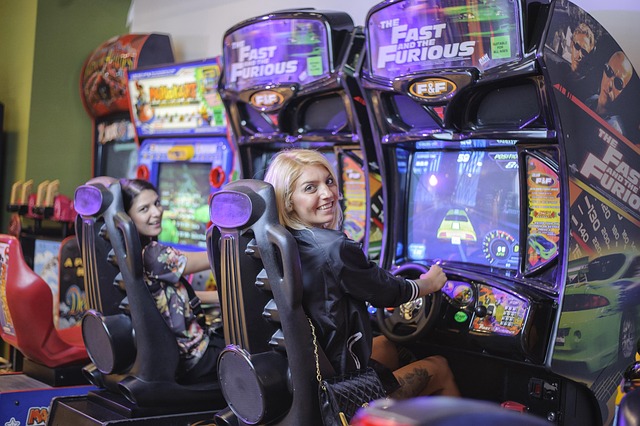Arcade machines have a rich history, evolving from mechanical amusements to sophisticated digital entertainment systems. Their cultural significance spans over a century, transitioning from public venues to modern domestic settings. Below, I provide a detailed history of arcade machines, an overview of their current state in 2025, and an analysis of their popularity in UK homes.
History of Arcade Machines
Early Beginnings: Pre-20th Century
The origins of arcade machines lie in the mechanical amusement devices of the late 19th century. These precursors emerged in Europe and North America, often found in public spaces like fairs, pubs, and seaside resorts:
- Penny Arcades: In the 1880s, coin-operated machines like fortune-tellers, strength testers, and mutoscopes (early motion-picture devices) appeared in “penny arcades.” In the UK, seaside towns like Blackpool and Brighton became hubs for these amusements, offering cheap entertainment for working-class holidaymakers.
- Mechanical Games: Early machines, such as bagatelle (a precursor to pinball) and coin-operated shooting galleries, relied on springs, levers, and gravity. These were crafted from wood and metal, with minimal electrical components.
- Cultural Context: In Victorian Britain, amusement machines were often viewed with suspicion, associated with gambling and idleness, yet their affordability (typically 1d or 2d per play) ensured popularity.
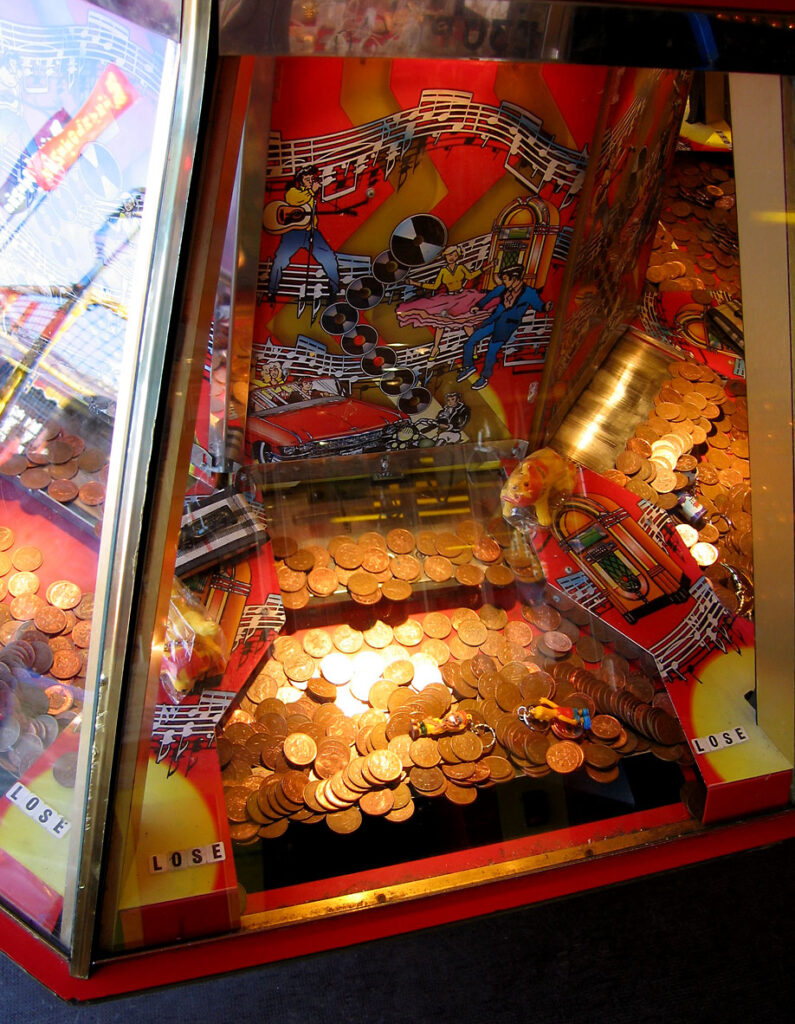
The Electromechanical Era: 1900–1960s
The early 20th century saw advancements in electrical engineering, transforming arcade machines into electromechanical devices:
- Pinball Machines: Introduced in the 1930s, pinball machines became a defining arcade staple. Early models like Baffle Ball (1931) by Gottlieb used mechanical scoring and no flippers. By the 1940s, flippers were added, enhancing player control. In the UK, pinball was popular in arcades and cafes, though gambling associations led to occasional bans.
- Jukeboxes and Novelty Games: Coin-operated jukeboxes, claw machines, and shooting games proliferated in the 1950s. Companies like Wurlitzer (US) and NSM (Germany) supplied UK venues with jukeboxes, while British firms like Bell-Fruit produced fruit machines for pubs.
- Seaside Arcades: UK coastal resorts, such as Margate and Scarborough, became synonymous with arcades, housing rows of mechanical and electromechanical games. These venues catered to families and youth, with games costing 6d to 1s by the 1950s.
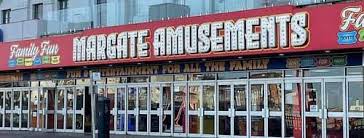
The Video Game Revolution: 1970s–1980s
The introduction of video-based arcade machines in the 1970s marked a seismic shift, ushering in the “golden age” of arcades:
- Pioneering Games: Computer Space (1971), the first commercial video arcade game, was followed by Atari’s Pong (1972), a simple tennis simulation that became a global hit. In the UK, Pong clones appeared in pubs and arcades by 1973.
- Iconic Titles: The late 1970s and 1980s saw classics like Space Invaders (1978), Pac-Man (1980), Donkey Kong (1981), and Street Fighter II (1991). These games, developed by Japanese firms like Taito, Namco, and Capcom, dominated UK arcades, offering immersive graphics and competitive gameplay.
- Technology: Early video arcade machines used CRT monitors, custom microprocessors, and ROM chips. Cabinets were wooden, often adorned with vibrant artwork, costing £1,000–£3,000 each in the 1980s (equivalent to £3,500–£10,000 in 2025).
- Cultural Impact: Arcades became youth culture hubs in the UK, found in city centres (e.g., London’s Trocadero) and seaside resorts. Games cost 10p–50p per play, attracting teenagers and young adults. However, arcades also faced criticism for encouraging truancy and petty crime.
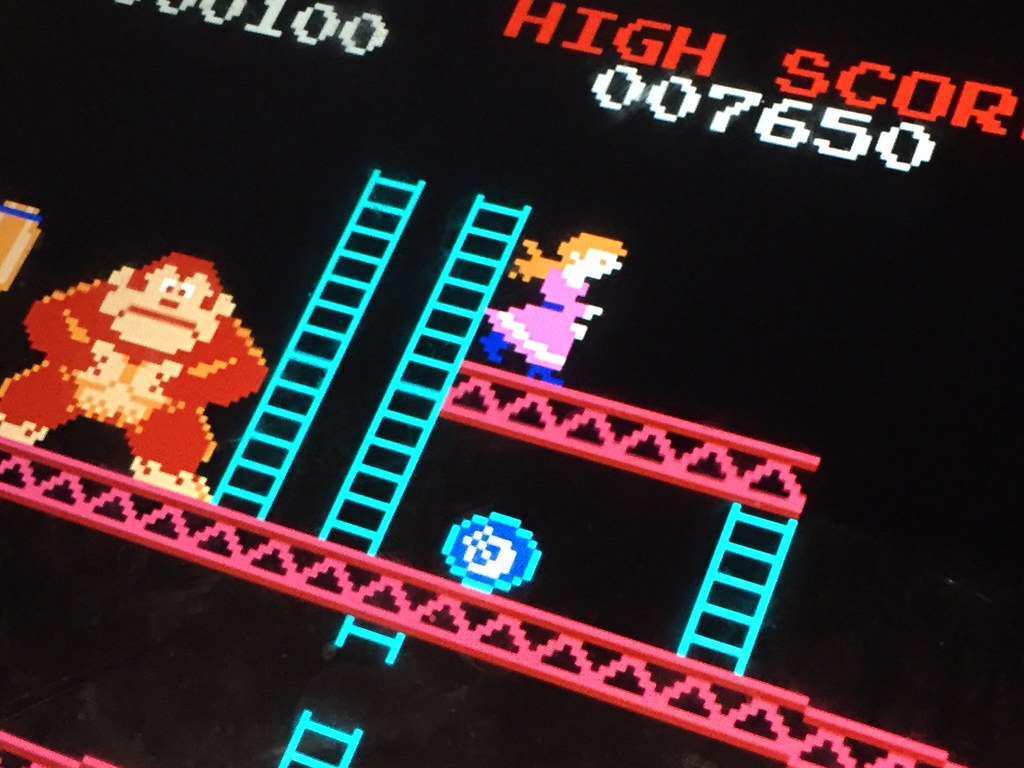
Decline and Adaptation: 1990s–2000s
By the 1990s, arcades faced challenges from home consoles and changing social trends:
- Console Competition: Systems like the Sony PlayStation (1994) and Nintendo 64 (1996) offered arcade-quality graphics at home, reducing arcade visits. Games like Tekken and Virtua Fighter were quickly ported to consoles, diminishing arcades’ exclusivity.
- Specialized Machines: To compete, arcades introduced larger, immersive machines, such as driving simulators (Sega Rally, 1995), dance games (Dance Dance Revolution, 1998), and light-gun shooters (Time Crisis, 1995). These cost £5,000–£20,000 per unit but offered experiences unavailable at home.
- UK Arcades: Many traditional arcades closed, particularly in smaller towns, but seaside venues and large entertainment complexes (e.g., Namco Funscape) persisted. Ticket-redemption games, offering prizes, became popular for families, with plays costing 50p–£2.
- Nostalgia and Revival: By the 2000s, retro arcades catering to nostalgia emerged, showcasing restored 1980s machines. In the UK, events like the London Gaming Market began celebrating arcade culture.
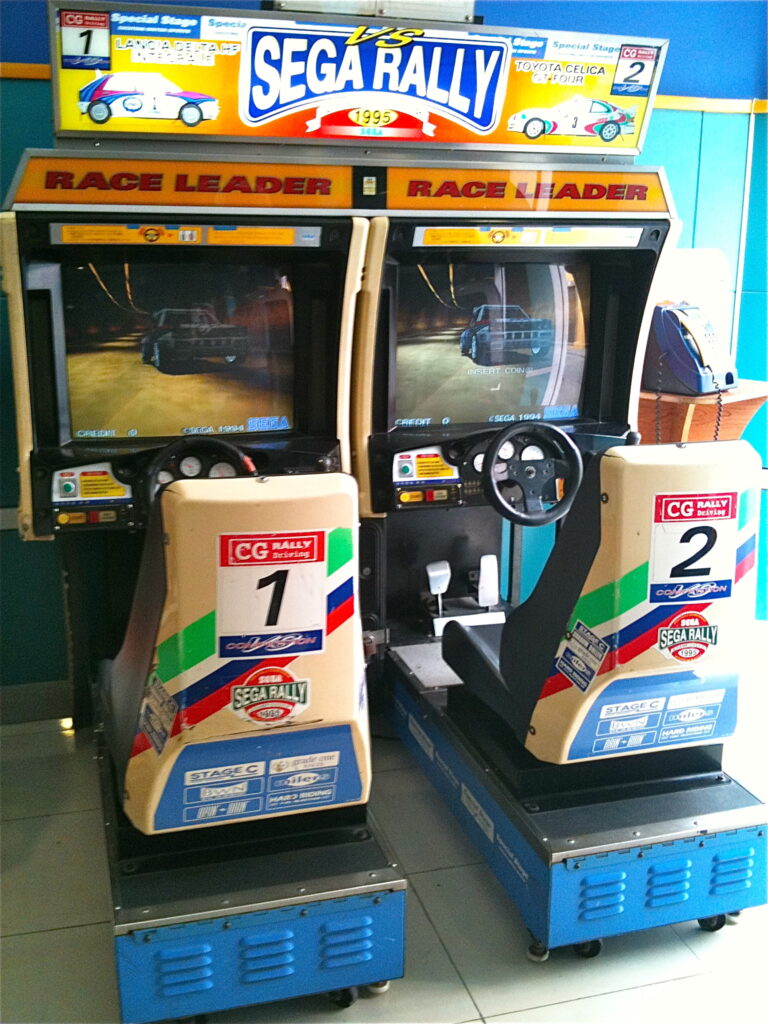
Modern Era: 2010s–2025
Since the 2010s, arcade machines have experienced a niche revival, driven by nostalgia, technological innovation, and new business models:
- Retro Arcades: Boutique arcades, such as Arcade Club in Bury and Leeds, offer extensive collections of vintage and modern machines, charging flat entry fees (£10–£20) rather than per play. These venues appeal to retro gamers and families.
- Modern Machines: Arcade games now incorporate touchscreens, VR headsets, and networked play. Titles like Raw Thrills’ Jurassic Park Arcade (2015) and Sega’s House of the Dead: Scarlet Dawn (2018) use HD displays and motion seats, costing £10,000–£30,000 per unit.
- Barcades: Hybrid bar-arcade venues, blending craft beer with classic games, have proliferated in UK cities like London, Manchester, and Bristol. Examples include Four Quarters and NQ64, where games cost 25p–£1 per play.
- Home Market Growth: The rise of affordable reproduction cabinets and emulation technology has made arcade machines viable for domestic use, as discussed below.
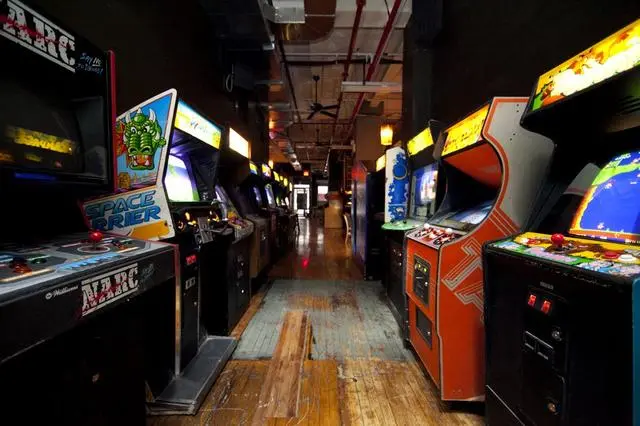
Arcade Machines in 2025
Types of Arcade Machines
- Classic Video Arcade Cabinets:
- Design: Upright or sit-down cabinets with CRT or LCD screens, joysticks, and buttons. Popular titles include Pac-Man, Galaga, and Mortal Kombat.
- Manufacturers: Companies like Arcade1Up (US) and Liberty Games (UK) produce ¾-scale replicas, standing 4–5 feet tall, designed for home use. Full-size restored originals are sold by specialists like Home Leisure Direct.
- Price: Arcade1Up replicas cost £300–£700, while restored 1980s cabinets range from £1,000–£3,000. Custom-built cabinets with modern hardware can exceed £5,000.
- Features: Modern replicas often include multiple games (50–200 titles) via emulation, Wi-Fi for leaderboards, and LED-lit marquees.
- Pinball Machines:
- Design: Digital or electromechanical tables with LED scoreboards and themed artwork (e.g., Stranger Things or Star Wars).
- Manufacturers: Stern Pinball (US) and Heighway Pinball (UK) dominate, offering professional-grade machines. Budget models use virtual pinball screens.
- Price: New Stern machines cost £6,000–£12,000, while virtual pinball tables start at £3,000. Second-hand 1990s machines (e.g., The Addams Family) range from £2,000–£5,000.
- Trends: Pinball remains a niche but passionate market, with UK enthusiasts forming clubs like the UK Pinball League.
- Claw Machines and Redemption Games:
- Design: Coin-operated machines offering prizes, common in commercial arcades but rare in homes due to size and maintenance.
- Price: Domestic claw machines cost £1,000–£3,000, often used for novelty or children’s parties.
- Use: Primarily found in family entertainment centres, not homes.
- Cocktail and Bartop Machines:
- Design: Cocktail tables (seated, with a glass-top screen) and bartop units (compact, countertop cabinets) are space-saving options for homes.
- Price: Cocktail tables range from £1,500–£4,000; bartop units cost £500–£1,500.
- Popularity: Cocktail tables are popular in UK homes for their retro aesthetic and dual use as furniture.
- VR and Immersive Machines:
- Design: Modern arcade machines with VR headsets, motion platforms, or 4D effects (e.g., wind or vibration). Examples include StarVR setups or Sega’s Storm Rider.
- Price: Domestic VR arcade units start at £2,000, with commercial-grade systems costing £10,000+.
- Trends: VR arcades are emerging in the UK, but home adoption is limited due to cost and space.
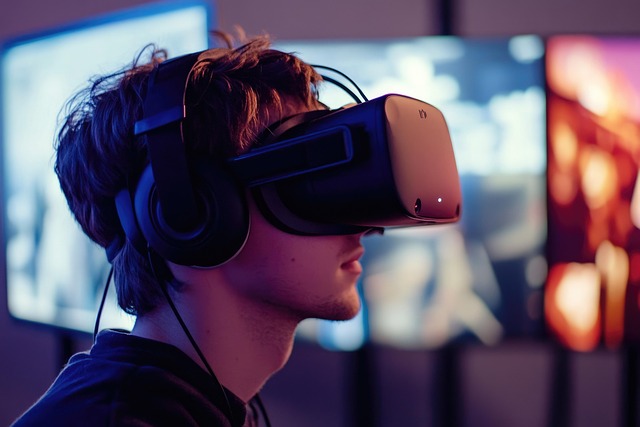
Technology in 2025
- Hardware: Modern arcade machines use Raspberry Pi or PC-based emulation for retro games, with LCD screens replacing CRTs. High-end machines feature 4K displays, haptic feedback, and cloud connectivity.
- Software: Emulation platforms like MAME allow thousands of games on a single cabinet. Licensed collections (e.g., Capcom’s Arcade Stadium) ensure legal gameplay.
- Customization: UK retailers offer bespoke cabinets with custom artwork, LED lighting, and game libraries tailored to buyer preferences.
- Maintenance: Modern machines require minimal upkeep, with solid-state components replacing mechanical parts. Restored classics need occasional repairs (e.g., CRT calibration or joystick replacement, costing £50–£200).

Commercial Arcade Landscape
- Venues: UK arcades remain viable in seaside resorts (e.g., Blackpool Pleasure Beach) and urban entertainment hubs. Chains like Hollywood Bowl and Bandai Namco Amusements invest in modern machines.
- Revenue Models: Flat-rate entry fees (£10–£20) or token systems (25p–£1 per play) are common. Redemption games generate significant income via prizes.
- Challenges: High machine costs and competition from mobile gaming limit growth, but nostalgia-driven venues thrive.
Popularity of Arcade Machines in UK Homes
Market Overview
Arcade machines have become increasingly popular in UK homes since the 2010s, driven by nostalgia, affordable replicas, and the rise of dedicated games rooms. While once a niche luxury, domestic arcade machines are now accessible to middle-class households, particularly among 30–50-year-olds who grew up in the 1980s arcade era.
Types and Costs
- Arcade1Up Replicas:
- Popularity: Arcade1Up’s ¾-scale cabinets, featuring games like Street Fighter II or Teenage Mutant Ninja Turtles, are best-sellers in the UK, available at retailers like Argos and Amazon.
- Cost: £300–£700, with bundles (including risers or stools) up to £900.
- Appeal: Compact size (fits in flats or small rooms), easy assembly, and affordable pricing make them ideal for casual gamers.
- Custom and Restored Cabinets:
- Popularity: Enthusiasts seek full-size cabinets, either restored originals or bespoke builds from companies like Bespoke Arcades or Home Leisure Direct.
- Cost: Restored cabinets cost £1,000–£3,000; custom units with modern emulation range from £2,000–£7,000.
- Appeal: Authentic arcade feel and high-quality construction attract serious collectors.
- Cocktail and Bartop Units:
- Popularity: Space-saving designs are popular in urban homes, particularly in cities like London or Manchester, where flats are common.
- Cost: £500–£4,000, depending on size and features.
- Appeal: Aesthetically pleasing and multifunctional, often used in living rooms or home bars.
- Pinball Machines:
- Popularity: A smaller but dedicated market, with collectors forming communities via forums like Pinside or UK Pinball Group.
- Cost: £2,000–£12,000, with high-end models for affluent buyers.
- Appeal: Tactile gameplay and collectible value draw enthusiasts.
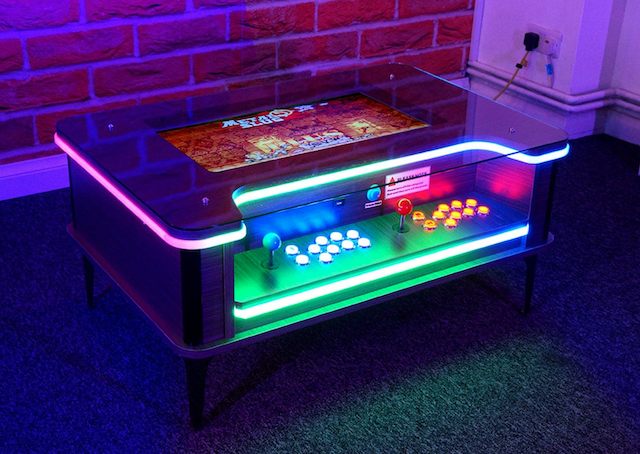
Space and Installation
- Room Requirements: A full-size cabinet (2m tall, 0.8m wide) fits in a spare room, garage, or converted loft. Cocktail tables suit living rooms, requiring 1.5m x 1m. Bartop units need only a countertop.
- Installation: Most home machines are plug-and-play, requiring no professional setup. Restored cabinets may need delivery (£50–£200) and calibration.
- Power: Standard UK 240V outlets suffice, with modern machines consuming 100–300W.
Cultural and Social Factors
- Nostalgia: UK buyers aged 30–50, who frequented arcades in the 1980s, drive demand, seeking to recreate childhood experiences. Social media platforms like X show enthusiasts sharing home arcade setups, boosting interest.
- Games Rooms: The trend for dedicated home entertainment spaces, particularly among suburban families, has increased arcade machine sales. Retailers report 20–30% annual growth in domestic arcade sales since 2020.
- Social Appeal: Arcade machines serve as social centrepieces for parties or family gatherings, offering multiplayer games unavailable on modern consoles.
- Urban vs. Rural: Urban buyers favour compact units (e.g., Arcade1Up or bartop machines) due to space constraints, while rural homeowners with larger properties invest in full-size cabinets or pinball tables.
Cost Considerations
- Entry-Level (£300–£1,000): Arcade1Up replicas and basic bartop units are affordable for casual buyers, offering 10–100 games.
- Mid-Range (£1,000–£3,000): Restored classics or custom cocktail tables appeal to enthusiasts, with 100–1,000 games via emulation.
- High-End (£3,000–£12,000+): Bespoke cabinets, pinball machines, or VR setups cater to affluent collectors, offering premium features.
- Additional Costs: Delivery (£50–£200), accessories (e.g., stools or marquee lights, £50–£300), and occasional repairs (£50–£500) add to expenses.
Trends in 2025
- Retro Emulation: Multi-game cabinets with thousands of titles (via MAME or RetroPie) are standard, reducing the need for single-game machines.
- Smart Features: Some machines offer Wi-Fi for online leaderboards or streaming integration, appealing to younger buyers.
- Sustainable Materials: Eco-conscious manufacturers use recycled wood or low-energy components, aligning with UK environmental trends.
- Customization: Buyers can choose cabinet artwork, button layouts, or game libraries, with companies like Bespoke Arcades charging £4,000–£7,000 for tailored designs.
- VR Integration: Domestic VR arcade units are emerging, though high costs (£2,000+) limit adoption.
Challenges and Limitations
- Space: Limited space in UK flats (average size 80m²) restricts adoption of full-size cabinets, pushing demand for compact units.
- Cost: High-end machines are prohibitively expensive for most households, with pinball tables particularly niche.
- Maintenance: Restored machines require occasional repairs, and sourcing parts for 1980s hardware can be costly (£100–£500).
- Competition: Home consoles, PC gaming, and mobile apps offer cheaper alternatives, though arcade machines’ tactile appeal remains unique.
Retail and Community
- Retailers: UK specialists like Home Leisure Direct, Liberty Games, and Arcade Direct dominate, with showrooms in cities like Bristol and London. Online platforms like Amazon and eBay offer budget options.
- Community: Enthusiast groups on X, Reddit, and forums like UKVAC (UK Vacuum Arcade Collectors) share tips on restoration and emulation. Events like Play Expo Manchester showcase home arcade setups.
- Second-Hand Market: Restored machines retain value, with 1980s cabinets selling for 60–80% of original cost on eBay or Arcade Trader.
Conclusion
Arcade machines have evolved from mechanical novelties in Victorian penny arcades to high-tech entertainment systems, with a golden age in the 1980s–1980s driven by video games like Pac-Man and Street Fighter. In 2025, UK arcades persist in niche venues, while domestic machines gain traction, fuelled by nostalgia and affordable replicas like Arcade1Up’s £300–£700 cabinets. Full-size restored units and bespoke builds (£1,000–£12,000) cater to enthusiasts, with compact designs suiting urban homes. Despite challenges like space and cost, arcade machines’ tactile charm and social appeal ensure growing popularity in UK homes a unique blend of entertainment and retro culture.

